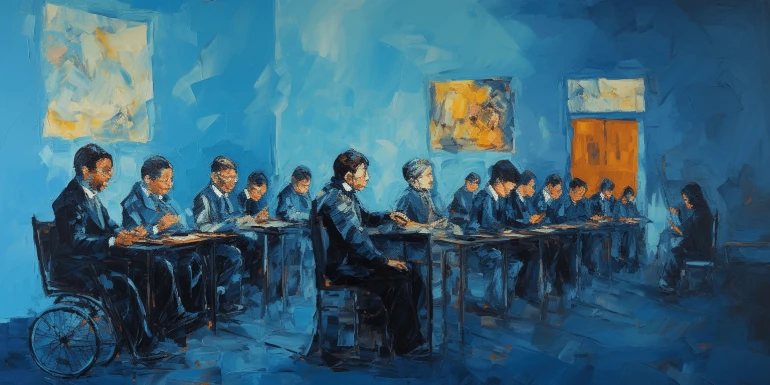What is an Inclusive Classroom?
An inclusive classroom, as per the inclusive classroom definition, is one that embraces the diversity of all students and strives to meet each of their unique learning needs. The key components of an inclusive classroom include accepting and welcoming differences in culture, abilities, skills, interests, backgrounds, and identities. It is founded on the belief that all children can learn, achieve high standards, and make positive contributions when provided with equitable opportunities, appropriate supports, and a nurturing environment.
Teachers foster community and create spaces where students feel safe, valued, challenged, and included. An inclusive model shifts away from a "one-size-fits-all" approach to make learning personal, flexible, and supportive for the natural range of human diversity. Students actively participate and learn to see from multiple perspectives, not only developing academic skills but life proficiencies.
Why Inclusive Classrooms Matter?
Research clearly demonstrates the wide-ranging benefits when schools adopt inclusive models:
- Increased sense of belonging and improved self-confidence for all students
- Higher academic achievement and motivation to learn
- Development of meaningful relationships and interpersonal skills
- A classroom community where each person is respected and valued
- Preparation for living harmoniously in a diverse society
By educating students with diverse needs together, inclusive classrooms build empathy, reduce prejudice, and support appropriate adaptations to allow full participation. Students model mutual care and respect, not only learning academic material but also the vital skills necessary to thrive in our global community.
Inclusive Classroom Environment
A truly inclusive classroom, with a focus on fostering an inclusive classroom environment, has an atmosphere characterized by care, concern, patience, and determination to help every student succeed. Both the physical setup and the culture of emotional safety are carefully structured to embrace diversity and create a profound sense of belonging among all students.
The room arrangement, learning stations, technology access, and activity spaces are designed so students of varying abilities can easily navigate and fully participate. Wall decor, images, materials, and content choices intentionally represent racial, cultural, ethnic diversity to foster connectedness.
Teachers nurture positive relationships and model mutual respect between all students. There are clear rules regarding bullying and intolerant behaviors. Cooperative activities encourage social bonding and perspective-taking. Praise for effort and improvement supports growth mindsets versus rigid expectations.
How to Create an Inclusive Classroom
While classroom formats differ greatly, some key principles of an inclusive layout include:
- Flexible seating options (cushions, mats, standing desks etc.)
- Accessible learning stations
- Uncluttered pathways between activity areas
- Appropriate assistive technologies
- Areas for emotional regulation and sensory input needs
- Inviting, vibrant aesthetics with student contributions
Promoting Social/Emotional Growth
Inclusive educators incorporate deliberate SEL strategies:
- Morning meetings for social bonding
- Cross-ability peer partnerships
- Team-building activities that affirm belonging
- Conflict resolution protocols
- Teaching and modeling emotional intelligence
- Celebrating unique talents, interests and strengths
Examples of Inclusive Teaching Strategies
Incorporating effective inclusive classroom strategies is essential for ensuring that all students can access learning in ways that align with their readiness levels, interests, and preferred modes of learning.
Adapting Lesson Delivery
Examples include:
- Multi-sensory presentation using visual, auditory and tactile modes
- Customizable pacing, break times as needed
- Closed captioning and text transcriptions
- Graphic organizers, manipulatives and hands-on options
- Explicit vocabulary previews
Offering Assignment Choices
Providing differentiated assignment options enables students to showcase understanding through venues matching ability and learning style. This may include:
- Customizing project rubrics and materials
- Alternative research and output formats (oral, podcast, video etc.)
- Tiered complexity prompts at different ability levels
- Choices related to topics and genres of interest
Peer Support Opportunities
Inclusive classrooms leverage peer strengths and shared growth through:
- Flexible small groups based on skill needs
- Partner and team assignments with clear roles
- Structured peer tutoring or “expert groups”
- Reciprocal teaching and collaborative dialogue
Culturally Inclusive Classroom
Students should see their cultural experiences reflected in the classroom landscape, including course curriculum, texts, activities, and materials. Representing diversity fosters identity affirmation and connects learning to student realities and backgrounds.
Diversifying Content
Content choices validate the stories and contributions of minority cultures. Examples include:
- Selecting authors, historical accounts, and scientific pioneers across cultures and demographics.
- Discussing current events related to cultural groups within the student community
- Infusing folklore, poetry and arts programs from various traditions
Classroom Libraries
Ensure classroom and mini libraries contain titles with:
- Protagonists and themes spanning life experiences
- Authors representing diverse cultural backgrounds
- Images, characters, story-lines that mirror student racial profiles
Supporting Students with Disabilities
In inclusive classrooms, students with IEPs, 504s and formal support services participate fully in learning environments aligned to their needs and abilities. General education teachers collaborate with specialists to provide appropriate accommodations, modifications and personalized supports.
Individual Education Programs (IEPs)
Every student receiving special education services in an inclusive classroom has an Individualized Education Plan (IEP) document detailing:
- Specific learning diagnoses and needs.
- Measurable learning goals.
- Custom supports and services.
- Accommodations for instruction and evaluating mastery.
504 Accommodation Plans
Section 504 plans outline assistance required for equal opportunity related to a student’s formal disability diagnosis not requiring specialized instruction. Common 504 accommodations include:
- Extended time for assignments/tests
- Assistive technology (audio texts)
- Behavior support or self-regulation plans
- Preferential seating
Creating an Inclusive Environment for All
At the leadership level, developing inclusive learning communities requires evolving attitudes, policies and frameworks using evidence-based practices. Ongoing teacher training in managing diverse classrooms empowers educators with tools and resources to nurture each unique learner.
Prioritizing relationship-building helps teachers view themselves as caring leaders who believe in every student, rather than waving the banner of normality and achievement. Compassion fosters intrinsic motivation more effectively than rewards or consequences. Affirming the human value in each person reverses exclusionary biases shaped by social hierarchies of ability, race, language, or appearance.
By championing inclusive environments district-wide, schools live out their highest calling - preparing global citizens to forge connections across the full spectrum of humanity.
Conclusion
Constructing classroom communities where everyone feels welcomed, affirmed, and supported requires ongoing intention and effort, but has life-long reverberations. Although adapting to meet specialized needs adds complexity for schools, research confirms the long-term academic and social payoffs. Offering differentiated, student-centered instruction isn’t just best pedagogical practice—it mirrors the diversity inherent in life itself. When education models the belief that limitations can be overcome with the right forms of nurturing and support, we help students see barriers as bridges and obstacles as opportunities for innovation. By working together to meet the needs of the most vulnerable, we discover solutions allowing everyone to thrive.




